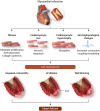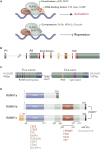RUNX1: an emerging therapeutic target for cardiovascular disease
- PMID: 32154891
- PMCID: PMC7314639
- DOI: 10.1093/cvr/cvaa034
RUNX1: an emerging therapeutic target for cardiovascular disease
Abstract
Runt-related transcription factor-1 (RUNX1), also known as acute myeloid leukaemia 1 protein (AML1), is a member of the core-binding factor family of transcription factors which modulate cell proliferation, differentiation, and survival in multiple systems. It is a master-regulator transcription factor, which has been implicated in diverse signalling pathways and cellular mechanisms during normal development and disease. RUNX1 is best characterized for its indispensable role for definitive haematopoiesis and its involvement in haematological malignancies. However, more recently RUNX1 has been identified as a key regulator of adverse cardiac remodelling following myocardial infarction. This review discusses the role RUNX1 plays in the heart and highlights its therapeutic potential as a target to limit the progression of adverse cardiac remodelling and heart failure.
Keywords: Adverse cardiac remodelling; Calcium; Cardiovascular diseases; Excitation–contraction coupling; Heart failure; Myocardial infarction; Runx1.
© The Author(s) 2020. Published by Oxford University Press on behalf of the European Society of Cardiology.
Figures



References
-
- Dewan P, Rørth R, Jhund PS, Ferreira JP, Zannad F, Shen L, Køber L, Abraham WT, Desai AS, Dickstein K, Packer M, Rouleau JL, Solomon SD, Swedberg K, Zile MR, McMurray JJV.. Income inequality and outcomes in heart failure: a global between-country analysis. JACC Heart Fail 2019;7:336–346. - PubMed
-
- Konstam MA, Kramer DG, Patel AR, Maron MS, Udelson JE.. Left ventricular remodeling in heart failure: current concepts in clinical significance and assessment. JACC Cardiovasc Imaging 2011;4:98–108. - PubMed
Publication types
MeSH terms
Substances
Grants and funding
LinkOut - more resources
Full Text Sources
Other Literature Sources

